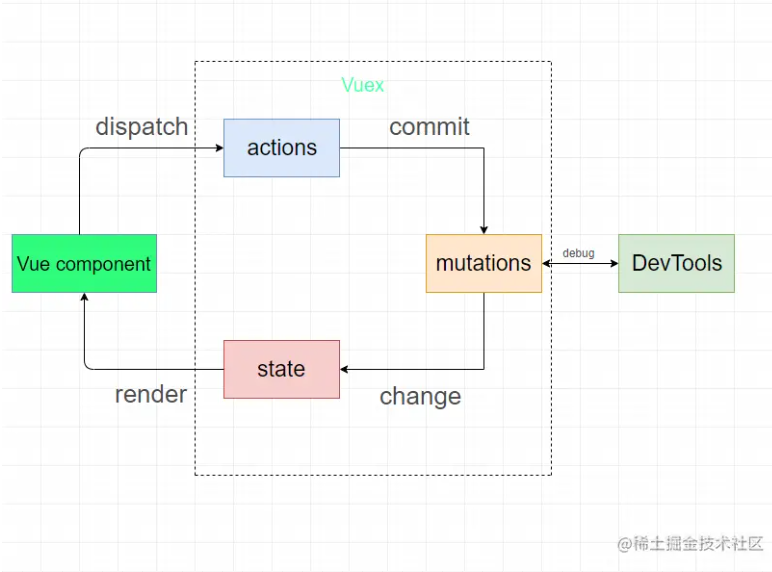
Pinia和Vuex一样都是是vue的全局状态管理器。其实Pinia就是Vuex5,只不过为了尊重原作者的贡献就沿用了这个看起来很甜的名字Pinia。
本文将通过Vue3的形式对两者的不同实现方式进行对比,让你在以后工作中无论使用到Pinia还是Vuex的时候都能够游刃有余。
既然我们要对比两者的实现方式,那么我们肯定要先在我们的Vue3项目中引入这两个状态管理器(实际项目中千万不要即用Vuex又用Pinia,不然你会被同事请去喝茶的。下面就让我们看下它们的使用方式吧
npm i vuex -S
npm i pinia -S
在src目录下新建vuexStore,实际项目中你只需要建一个store目录即可,由于我们需要两种状态管理器,所以需要将其分开并创建两个store目录
新建vuexStore/index.js
import { createStore } from 'vuex' export default createStore({ //全局state,类似于vue种的data state() { return { vuexmsg: "hello vuex", name: "xiaoyue", }; }, //修改state函数 mutations: { }, //提交的mutation可以包含任意异步操作 actions: { }, //类似于vue中的计算属性 getters: { }, //将store分割成模块(module),应用较大时使用 modules: { } })
main.js引入
import { createApp } from 'vue' import App from './App.vue' import store from '@/vuexStore' createApp(App).use(store).mount('#app')
App.vue测试
import { useStore } from 'vuex' let vuexStore = useStore() console.log(vuexStore.state.vuexmsg); //hello vuex " _ue_custom_node_="true">
页面正常打印hello vuex说明我们的Vuex已经挂载成功了
import { createApp } from "vue"; import App from "./App.vue"; import {createPinia} from 'pinia' const pinia = createPinia() createApp(App).use(pinia).mount("#app");
src下新建piniaStore/storeA.js
import { defineStore } from "pinia"; export const storeA = defineStore("storeA", { state: () => { return { piniaMsg: "hello pinia", }; }, getters: {}, actions: {}, });
import { storeA } from '@/piniaStore/storeA' let piniaStoreA = storeA() console.log(piniaStoreA.piniaMsg); //hello pinia " _ue_custom_node_="true">
从这里我们可以看出pinia中没有了mutations和modules,pinia不必以嵌套(通过modules引入)的方式引入模块,因为它的每个store便是一个模块,如storeA,storeB... 。 在我们使用Vuex的时候每次修改state的值都需要调用mutations里的修改函数(下面会说到),因为Vuex需要追踪数据的变化,这使我们写起来比较繁琐。而pinia则不再需要mutations,同步异步都可在actions进行操作,至于它没有了mutations具体是如何最终到state变化的,这里我们不过多深究,大概好像应该是通过hooks回调的形式解决的把(我也没研究过,瞎猜的。
获取state的值从上面我们已经可以一目了然的看到了,下面让我们看看他俩修改state的方法吧
vuex在组件中直接修改state,如App.vue
{ {vuexStore.state.vuexmsg}}import { useStore } from 'vuex' let vuexStore = useStore() vuexStore.state.vuexmsg = 'hello juejin' console.log(vuexStore.state.vuexmsg) " _ue_custom_node_="true">
可以看出我们是可以直接在组件中修改state的而且还是响应式的,但是如果这样做了,vuex不能够记录每一次state的变化记录,影响我们的调试。当vuex开启严格模式的时候,直接修改state会抛出错误,所以官方建议我们开启严格模式,所有的state变更都在vuex内部进行,在mutations进行修改。例如vuexStore/index.js:
import { createStore } from "vuex"; export default createStore({ strict: true, //全局state,类似于vue种的data state: { vuexmsg: "hello vuex", }, //修改state函数 mutations: { setVuexMsg(state, data) { state.vuexmsg = data; }, }, //提交的mutation可以包含任意异步操作 actions: {}, //类似于vue中的计算属性 getters: {}, //将store分割成模块(module),应用较大时使用 modules: {}, });
当我们需要修改vuexmsg的时候需要提交setVuexMsg方法,如App.vue
{ { vuexStore.state.vuexmsg }}import { useStore } from 'vuex' let vuexStore = useStore() vuexStore.commit('setVuexMsg', 'hello juejin') console.log(vuexStore.state.vuexmsg) //hello juejin " _ue_custom_node_="true">
或者我们可以在actions中进行提交mutations修改state:
import { createStore } from "vuex"; export default createStore({ strict: true, //全局state,类似于vue种的data state() { return { vuexmsg: "hello vuex", } }, //修改state函数 mutations: { setVuexMsg(state, data) { state.vuexmsg = data; }, }, //提交的mutation可以包含任意异步操作 actions: { async getState({ commit }) { //const result = await xxxx 假设这里进行了请求并拿到了返回值 commit("setVuexMsg", "hello juejin"); }, } });
组件中使用dispatch进行分发actions
{ { vuexStore.state.vuexmsg }}import { useStore } from 'vuex' let vuexStore = useStore() vuexStore.dispatch('getState') " _ue_custom_node_="true">
一般来说,vuex中的流程是首先actions一般放异步函数,拿请求后端接口为例,当后端接口返回值的时候,actions中会提交一个mutations中的函数,然后这个函数对vuex中的状态(state)进行一个修改,组件中再渲染这个状态,从而实现整个数据流程都在vuex内部进行便于检测。直接看图,一目了然

相比于Vuex,Pinia是可以直接修改状态的,并且调试工具能够记录到每一次state的变化,如App.vue
{ { piniaStoreA.piniaMsg }}import { storeA } from '@/piniaStore/storeA' let piniaStoreA = storeA() console.log(piniaStoreA.piniaMsg); //hello pinia piniaStoreA.piniaMsg = 'hello juejin' console.log(piniaStoreA.piniaMsg); //hello juejin " _ue_custom_node_="true">
使用$patch方法可以修改多个state中的值,比如我们在piniaStore/storeA.js中的state增加一个name
import { defineStore } from "pinia"; export const storeA = defineStore("storeA", { state: () => { return { piniaMsg: "hello pinia", name: "xiaoyue", }; }, getters: {}, actions: {}, });
然后我们在App.vue中进行修改这两个state
import { storeA } from '@/piniaStore/storeA' let piniaStoreA = storeA() console.log(piniaStoreA.name); //xiaoyue piniaStoreA.$patch({ piniaMsg: 'hello juejin', name: 'daming' }) console.log(piniaStoreA.name);//daming
当然也是支持修改单个状态的如
piniaStoreA.$patch({ name: 'daming' })
$patch还可以使用函数的方式进行修改状态
import { storeA } from '@/piniaStore/storeA' let piniaStoreA = storeA() cartStore.$patch((state) => { state.name = 'daming' state.piniaMsg = 'hello juejin' })
不同于Vuex的是,Pinia去掉了mutations,所以在actions中修改state就行Vuex在mutations修改state一样。其实这也是我比较推荐的一种修改状态的方式,就像上面说的,这样可以实现整个数据流程都在状态管理器内部,便于管理。
在piniaStore/storeA.js的actions添加一个修改name的函数
import { defineStore } from "pinia"; export const storeA = defineStore("storeA", { state: () => { return { piniaMsg: "hello pinia", name: "xiao yue", }; }, actions: { setName(data) { this.name = data; }, }, });
组件App.vue中调用不需要再使用dispatch函数,直接调用store的方法即可
import { storeA } from '@/piniaStore/storeA' let piniaStoreA = storeA() piniaStoreA.setName('daming')
Pinia可以使用$reset将状态重置为初始值
import { storeA } from '@/piniaStore/storeA' let piniaStoreA = storeA() piniaStoreA.$reset()
Copyright © 2023 leiyu.cn. All Rights Reserved. 磊宇云计算 版权所有 许可证编号:B1-20233142/B2-20230630 山东磊宇云计算有限公司 鲁ICP备2020045424号
磊宇云计算致力于以最 “绿色节能” 的方式,让每一位上云的客户成为全球绿色节能和降低碳排放的贡献者